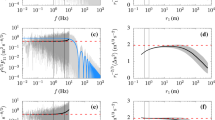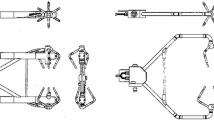Abstract
In this note we reassess the role of sonic thermometry in boundary-layer studies. The sonic temperature signal, when corrected for crosswind velocity contamination, very closely approximates the virtual temperature of air. This variable is needed for many boundary-layer calculations. We describe preliminary tests with a new sonic anemometer-thermometer that performs the velocity correction in real time. Our test results offer new insights into the nature of the velocity error on temperature standard deviations and fluxes. They also draw attention to the high noise threshold that appears as an f +1 rise in the fS(f) spectrum when spectral levels drop below 10-4 °C2.
Similar content being viewed by others
References
Hanafusa, T., Fujitani, T., Kobori, Y. and Mitsuta, Y.: 1982, ‘A New Type Sonic Anemometer-Thermometer for Field Operation’, Pap. Meteorol. Geophys. 33, 1–19.
Kaimal, J. C.: 1969, ‘Measurement of Momentum and Heat Flux Variations in the Surface Boundary Layer’, Radio Sci. 4, 1147–1153.
Kaimal, J. C. and Businger, J. A.: 1963, ‘A Continuous Wave Sonic Anemometer-Thermometer’, J. Appl. Meteorol. 2, 156–164.
Kaimal, J. C. and Gaynor, J. E.: 1983, ‘The Boulder Atmospheric Observatory’, J. Appl. Meteorol. 22, 863–880.
Kaimal, J. C., Gaynor, J. E., Zimmerman, H. A. and Zimmerman, G. A.: 1990, ‘Minimizing Flow Distortion Errors in a Sonic Anemometer’, Boundary-Layer Meteorol. 53, 103–115.
May, P. T., Strauch, R. G., Moran, K. P. and Ecklund, W. L.: 1990, ‘Temperature Sounding by RASS with Wind Profiler Radars’, IEEE Trans. Geosci. Remote Sens. 28, 19–28.
Miller, D. C.: 1937, Sound Waves — Their Shape and Speed, The Macmillan Co., New York, 164 pp.
Mitsuta, Y.: 1966, ‘Sonic Anemometer-Thermometer for General Use’, J. Meteorol. Soc. Japan 44, 12–24.
Mitsuta, Y.: 1974, ‘Sonic Anemometer-Thermometer for Atmospheric Turbulence Measurements’, in R. B. Dowdell (ed.), Flow — Its Measurement and Control in Science and Industry, Vol. 1, Instrument Society of America, 341–347.
Priestley, J. T. and Hill, R. J.: 1985, ‘Measuring High-Frequency Humidity, Temperature and Radio Refractive Index in the Surface Layer’, J. Atmos. Oceanic Technol. 2, 233–251.
Schmitt, K. F., Friehe, C. A. and Gibson, C. H.: 1978, ‘Humidity Sensitivity of Atmospheric Temperature Sensors by Salt Contamination’, J. Phys. Oceanogr. 8, 151–161.
Schotanus, P., Nieuwstadt, F. T. M. and DeBruin, H. A. R.: 1983, ‘Temperature Measurement with a Sonic Anemometer and its Application to Heat and Moisture Fluctuations’, Boundary-Layer Meteorol. 26, 81–93.
Suomi, V. E.: 1957, ‘Energy Budget Studies and Development of the Sonic Anemometer for Spectrum Analysis’, AFCRC Tech. Report 56-274, University of Wisconsin, Dept. of Meteorology, 91 pp.
Author information
Authors and Affiliations
Rights and permissions
About this article
Cite this article
Kaimal, J.C., Gaynor, J.E. Another look at sonic thermometry. Boundary-Layer Meteorol 56, 401–410 (1991). https://doi.org/10.1007/BF00119215
Accepted:
Issue Date:
DOI: https://doi.org/10.1007/BF00119215




